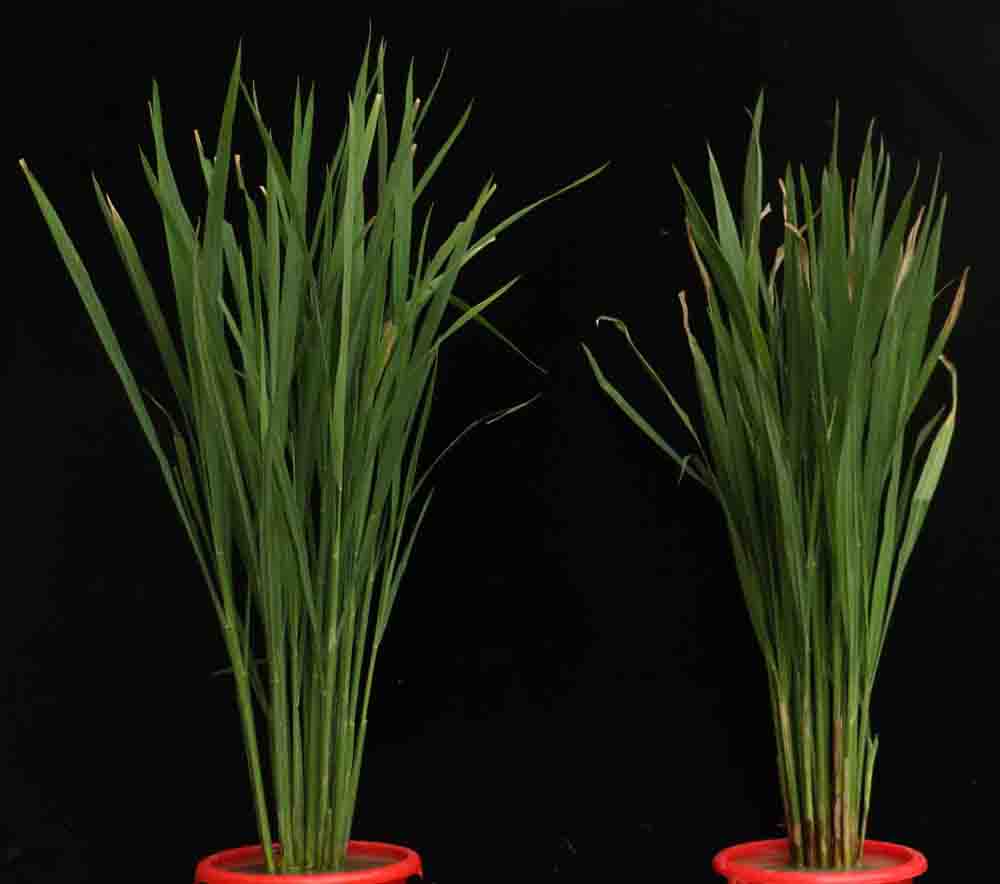

Genotypic Diversity and Pathogenisity of Xanthomonas oryzae pv. oryzae Isolated from Southern China in 2019-2021
† These authors contributed equally to this paper.
Received date: 2022-08-03
Accepted date: 2023-02-09
Online published: 2023-03-06

Tian Chuanyu , Fang Yanli , Shen Qing , Wang Hongjie , Chen Xifeng , Guo Wei , Zhao Kaijun , Wang Chunlian , Ji Zhiyuan . Genotypic Diversity and Pathogenisity of Xanthomonas oryzae pv. oryzae Isolated from Southern China in 2019-2021[J]. Chinese Bulletin of Botany, 2023 , 58(5) : 743 -749 . DOI: 10.11983/CBB22183
| [1] | 张华, 姜英华, 胡白石, 刘凤权, 许志刚 (2008). 利用PCR技术专化性检测水稻细菌性条斑病菌. 植物病理学报 38, 1-5. |
| [2] | Antony G, Zhou JH, Huang S, Li T, Liu B, White F, Yang B (2010). Rice xa13 recessive resistance to bacterial blight is defeated by induction of the disease susceptibility gene Os-11N3. Plant Cell 22, 3864-3876. |
| [3] | Boch J, Bonas U, Lahaye T (2014). TAL effectors-pathogen strategies and plant resistance engineering. New Phy- tol 204, 823-832. |
| [4] | Breia R, Conde A, Badim H, Fortes AM, Gerós H, Granell A (2021). Plant SWEETs: from sugar transport to plant-pathogen interaction and more unexpected physiological roles. Plant Physiol 186, 836-852. |
| [5] | Doyle EL, Stoddard BL, Voytas DF, Bogdanove AJ (2013). TAL effectors: highly adaptable phytobacterial virulence factors and readily engineered DNA-targeting proteins. Trends Cell Biol 23, 390-398. |
| [6] | Ji CH, Ji ZY, Liu B, Cheng H, Liu H, Liu SZ, Yang B, Chen GY (2020). Xa1 Allelic R genes activate rice blight resistance suppressed by interfering TAL effectors. Plant Commun 1, 100087. |
| [7] | Ji ZY, Guo W, Chen XF, Wang CL, Zhao KJ (2022). Plant executor genes. Int J Mol Sci 23, 1524. |
| [8] | Ji ZY, Ji CH, Liu B, Zou LF, Chen GY, Yang B (2016). Interfering TAL effectors of Xanthomonas oryzae neutralize R-gene-mediated plant disease resistance. Nat Commun 7, 13435. |
| [9] | Ji ZY, Wang CL, Zhao KJ (2018). Rice routes of countering Xanthomonas oryzae. Int J Mol Sci 19, 3008. |
| [10] | Ji ZY, Zakria M, Zou LF, Xiong L, Li Z, Ji GH, Chen GY (2014). Genetic diversity of transcriptional activator-like effector genes in Chinese isolates of Xanthomonas oryzae pv. oryzicola. Phytopathology 104, 672-682. |
| [11] | Ni?o-Liu DO, Ronald PC, Bogdanove AJ (2006). Xanthomonas oryzae pathovars: model pathogens of a model crop. Mol Plant Pathol 7, 303-324. |
| [12] | Nowack MK, Holmes DR, Lahaye T (2022). TALE-induced cell death executors: an origin outside immunity? Trends Plant Sci 27, 536-548. |
| [13] | Oliva R, Ji CH, Atienza-Grande G, Huguet-Tapia JC, Perez-Quintero A, Li T, Eom JS, Li CH, Nguyen H, Liu B, Auguy F, Sciallano C, Luu VT, Dossa GS, Cunnac S, Schmidt SM, Slamet-Loedin IH, Vera Cruz C, Szurek B, Frommer WB, White FF, Yang B (2019). Broad- spectrum resistance to bacterial blight in rice using genome editing. Nat Biotechnol 37, 1344-1350. |
| [14] | Perez-Quintero AL, Szurek B (2019). A decade decoded: spies and hackers in the history of TAL effectors research. Annu Rev Phytopathol 57, 459-481. |
| [15] | Sambrook J, Fritsch EF, Maniatis T (1989). Molecular Cloning: A Laboratory Manual, 2nd edn. Cold Spring Harbor: Cold Spring Harbor Laboratory. |
| [16] | Wang CL, Qin TF, Yu HM, Zhang XP, Che JY, Gao Y, Zheng CK, Yang B, Zhao KJ (2014). The broad bacterial blight resistance of rice line CBB23 is triggered by a novel transcription activator-like (TAL) effector of Xanthomonas oryzae pv. oryzae. Mol Plant Pathol 15, 333-341. |
| [17] | White FF, Yang B (2009). Host and pathogen factors controlling the rice-Xanthomonas oryzae interaction. Plant Physiol 150, 1677-1686. |
| [18] | Xu ZY, Xu XM, Gong Q, Li ZY, Li Y, Wang S, Yang YY, Ma WX, Liu LY, Zhu B, Zou LF, Chen GY (2019). Engineering broad-spectrum bacterial blight resistance by simultaneously disrupting variable TALE-binding elements of multiple susceptibility genes in rice. Mol Plant 12, 1434-1446. |
| [19] | Xu ZY, Zou LF, Ma WX, Cai LL, Yang YY, Chen GY (2017). Action modes of transcription activator-like effectors (TALEs) of Xanthomonas in plants. J Integr Agric 16, 2736-2745. |
| [20] | Yang B, Sugio A, White FF (2006). Os8N3 is a host disease-susceptibility gene for bacterial blight of rice. Proc Natl Acad Sci USA 103, 10503-10508. |
| [21] | Zhang BM, Zhang HT, Li F, Ouyang YD, Yuan M, Li XH, Xiao JH, Wang SP (2020). Multiple alleles encoding atypical NLRs with unique central tandem repeats in rice confer resistance to Xanthomonas oryzae pv. oryzae. Plant Commun 1, 100088. |
| [22] | Zhou JH, Peng Z, Long JY, Sosso D, Liu B, Eom JS, Huang S, Liu SZ, Vera Cruz C, Frommer WB, White FF, Yang B (2015). Gene targeting by the TAL effector PthXo2 reveals cryptic resistance gene for bacterial blight of rice. Plant J 82, 632-643. |
| [23] | Zhou JM, Zhang YL (2020). Plant immunity: danger perception and signaling. Cell 181, 978-989. |
/
| 〈 |
|
〉 |